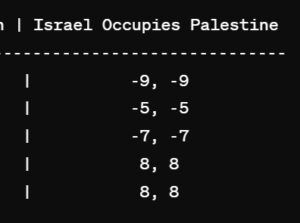Creating such a comprehensive analysis would be beyond the scope of what I can provide, especially in the time constraints of a single response. However, I can offer a simplified version of what you’re asking for.
### Most Exported Goods and Services:
1. Goods: Electronics, automobiles, machinery, petroleum products, pharmaceuticals.
2. Services: Financial services, tourism, IT services, consulting.
### Potential Bottlenecks:
1. Economic disparity leading to social unrest.
2. Resource competition (water, oil, rare earth minerals).
3. Territorial disputes.
4. Ethnic and religious tensions.
5. Political instability and failed states.
Hypothetical Triggers for Conflict:
1. Aggressive territorial expansion (e.g., Russia-Ukraine conflict).
2. Violent regime changes (e.g., Myanmar, Venezuela).
3. Proxy wars fueled by major powers (e.g., Syria, Yemen).
4. Ideological conflicts (e.g., North-South Korea).
5. Resource scarcity leading to competition (e.g., disputes in the South China Sea).
### Allies and Enemies:
Alliances are complex and constantly evolving. They often depend on shared interests, historical ties, and strategic considerations. Some hypothetical alliances might include:
1. Allies: NATO countries, EU member states, US allies in Asia (Japan, South Korea, Australia), GCC countries, ASEAN nations.
2. Potential Enemies: Russia, China (in certain scenarios), North Korea, Iran, non-state actors like terrorist organizations.
### Market Reactions:
Major events like conflicts or regime changes can impact markets in various ways:
1. **Stock Markets:** Uncertainty often leads to volatility. Military conflicts or political instability in key regions can lead to selloffs.
2. **Commodities:** Oil prices can spike due to supply disruptions. Precious metals like gold may rise as investors seek safe havens.
3. **Currencies:** Geopolitical tensions can lead to flight to safety currencies like the US dollar or Swiss franc.
### Game Theory Payoff Matrix (simplified):
Below is a very simplified and hypothetical example:


In this hypothetical matrix, the numbers represent the utility or payoff for each country. Negative values indicate losses, while positive values indicate gains. The higher the number, the better the outcome for the respective country.
Remember, this is a simplified and hypothetical representation. In reality, the outcomes would depend on numerous factors, including diplomatic efforts, military capabilities, and public opinion. Additionally, the moral and ethical considerations of war are not captured in such a matrix.

